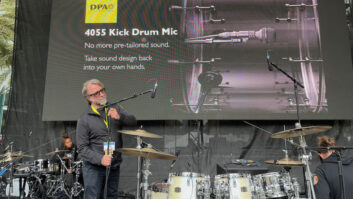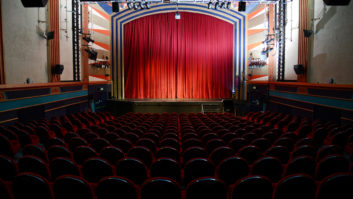
Now that was a NAMM show! If anyone is still looking for anecdotal proof that the economy is on the upswing, the Anaheim Convention Center would be a good place to start: record attendance (more than 95,000), plenty of celebrity sightings and a flood of new technology introductions.
advertisement
iOS capability seemed to be everywhere, as were live sound products, both in system control and hardware/software integration. And there was no shortage of studio tools, from Universal Audio’s much-trumpeted introduction of Apollo to Audio-Technica’s 50th anniversary limited-editions of its ever-popular microphones to MOTU’s release of DP 8, now available for PC users.
We’ll have much more product news and developments over the coming weeks, but here are some products and technologies that caught the attention of the Mix editors.
For the Studio
Over the past year of product introductions in the pro audio market, no category has been more competitive than the audio interface and converter markets. More features, more ins and outs, and now touchscreens and single-knob functionality. System-based approaches. It seems there is great demand for getting quality audio into the computers, and it was evident at NAMM.

Universal Audio Apollo interface
The biggest headline grabber was Universal Audio’s unveiling of the Apollo Interface, which includes four preamps, 18/24 channels of I/O (Mac/PC), real-time UAD processing, optional Thunderbolt I/O and much more. The company has measured sub-2ms latency with plug-ins in line, making Apollo a real option for tracking.
Meanwhile, Sonnox announced that it is now development partners for the UAD platform. This will bring Sonnox’s mixing and mastering plug-ins to UAD-2 DSP Accelerator hardware.
Apogee introduced the Duet Breakout Box, which enhances the company’s popular USB interface. The unit sports two ¼-inch instrument jacks, two XLR mic inputs, and a pair of XLR outputs, and it connects to the Duet 2 interface with multi-pin connector.
Steinberg debuted the UR824 and UR28M. The UR824 is a 24-bit/96 kHz USB 2 audio interface, with analog 8-in/8-out and 8 Class A mic pre’s; two pairs of ADAT optical I/O providing up to 16-in/16-out; word clock I/O with two BNC connectors; and two headphone buses. It comes with Cubase AI6 software and is cross-platform Mac/PC.
Although it’s been shown before to audio pros, the Focusrite Scarlett 2i2 garnered a lot of attention: two ins, two outs, two preamps. And priced for the home recordist/musician.
advertisement

Lynx Hilo 2-channel AD/DA converter
Not to be outdone, on the converter front, Lynx made a splash with the NAMM debut of Hilo, a 2-channel AD/DA converter with touchscreen interface, separate monitor/headphone outs, multiple digital options (AES/EBU via XLR, optical I/O, S/PDIF), an expansion port for future protocols, high-speed USB 2 interface, and onboard 32×32 mixer.

MOTU Digital Performer 8
MOTU had some groundbreaking news in the release of DP 8, which will now run on the PC platform. Version 8 includes a new video playback engine, Punch Guard confidence recording, 14 new user interface themes, and 15 new included plug-ins.

AEA KU4 ribbon microphone
Steven Slate’s Raven X1 console attracted no less than Mike Clink and Mike Shipley to the booth for demos. It’s a new look at the large format console that includes Avid fader packs, bounteous room for OB gear, an iPhone/iPad dock and more.
Wes Dooley was showing off his excellent KU4 ribbon microphone which is a throwback to the legendary RCA KU-3A from the 1950s. Watch for an upcoming review in the February issue of Mix magazine.
DPA had the dual-ear version of its d:fine headset mic. The unit comes with omni or cardioid capsules and offers a wide range of flexible options for adjusting both the mic and earpieces.
PMI displayed a re-creation of the Valley People dyna-mite dynamics processor in a 500-series format. The built-in TT jacks allow you to link several of these modules together.

Dangerous Music Source monitoring system
Priced for the personal studio, the Dangerous Music Source is a monitoring system that includes the same converters used in the company’s more expensive monitoring products. The unit includes two D/A converters, allowing you to route analog (stereo 1/8-inch and a pair of XLR/TRS combo jacks) and digital (USB, AES/EBU, and S/PDIF) inputs to separate headphone and speaker outputs.

Radial EXTC-SA reamping box
The Radial EXTC-SA is a reamping box that accepts a balanced +4 line-level signal and provides two unbalanced, high-impedance signals for use with effects pedals and guitar amplifiers. The box includes a phase inversion switch and a blend control.
advertisement
Chandler Ltd. showed its new 19W, EL34-based tube amp with a very interesting feature—a knob that changes the tube bias of the gain stage. Four bias presets are available. The amp also includes high and low shelving EQ, as well as a Shape knob that controls distortion and midrange characteristics.

Moog Music The Ladder
The Ladder from Moog Music is a redesign of a Bob Moog classic that offers 2- and 4-pole highpass and lowpass resonant filtering in a 500-Series module. The filter includes a 2-stage envelope and a drive control.
Waves had its NLS Non-Linear Summing Plugin in the booth. NLS brings users the analog summing sound of three legendary consoles, including the SSL 4000G belonging to Mark “Spike” Stent, the EMI TG12345 Mk 4 desk owned by Mike Hedges (The Cure, Siouxsie and the Banshees, Dido, U2), and the Neve 5116 console custom-made for Yoad Nevo (Bryan Adams, Pet Shop Boys, Sugababes, Goldfrapp, Air).
Audio-Technica proudly displayed its 50th Anniversary Limited Edition set of products, including versions of A-T’s ATH-M50s, AE4100, AE5400, AE6100, AT4050 and the legacy ATM25 microphone. The LE/Anniversary limited editions, feature A-T’s classic silver-colored metallic finish with blue accents, and the AT4050URUSHI sports a stunning traditional urushi lacquer finish with hand-painted Japanese maple leaves.

Lauten Audio FC-387 ‘Atlantis’ condenser mic
Lauten Audio showed the FC-387 “Atlantis” model, a solid-state multi-functional, large-diaphragm condenser made in collaboration with engineer “Fab” Dupont. It features multiple switches for three different polar patterns, gain, and unique timbre settings.
Live Is Alive!
The presence of Live Sound and Installation manufacturers was bigger than ever at NAMM, with plenty of speakers aimed at the portable market, some traditional mixers and line array systems, advances and expansion in system control, and a flurry of innovation in the iOs-based mix functionality.

Line 6 StageScape M20d
Line 6 introduced StageSource L3t and L3s, an innovative networkable live-sound system. Each cabinet offers a 1,400-watt, 3-way, tri-amped speaker setup with multichannel inputs and DSP effects. In addition, each speaker has a positional sensor that automatically tailors the sound of the unit based on how it’s used—vertically as a P.A. or horizontally as a monitor. Line 6 also introduced the StageScape M20d DSP-enhanced digital mixing system, a controller with a user-friendly, touch-screen interface, auto-sensing I/O, DSP effects, and wireless connectivity using an iPad.
advertisement
The big news for Mackie is the DL1608, a digital live sound mixer with iPad control that offers 16 Onyx preamps, 24-bit converters, DSP, and snapshot recall. The mixer can be controlled wirelessly from the iPad, allowing you to mix from anywhere in the venue.
PreSonus, which was into iPad mix control early on, was showing off its latest StudioLive software sporting Rational Acoustics’ Smaart Measurement Technology for sound-system analysis and optimization directly into PreSonus Virtual StudioLive remote-control/editor/librarian software.
But control is no longer simply about the console. System control is the buzz in both touring sound and the installation/contractor market.

QSC Core 500i
QSC, looking to bring its powerful Q-Sys Core technology to a wider range of installations, showed the Core 500i and Core 250i. Each has eight card slots and is capable of 128 and 64 network channels, respectively. The processing power is real, running under a custom Linux OS on Intel-based motherboards, connecting via Layer 3 Gigabit Ethernet hardware.

Peavey PVX Series line of powered speakers
Peavey put a lot of focus on its AT-200 guitar, developed in partnership with Antares and incorporating Auto-Tune DSP into the body. Auto-tuning, auto-intonation up and down the neck. A great demo on the floor. But they also showed iOS capability on MediaMatrix control software, bringing the technology down to the high-end home, church or nightclub; and they debuted their PVX Series line of powered speakers—12s and 15s—as well as the Triflex package incorporating a sub for portable P.A.
DiGiCo debuted UB MADI, which allows any computer to plug-and-play with its SD range of consoles over USB 2—up to 48 simultaneous inputs and outputs, incorporating the company’s latest Stealth Digital Processing FPGA technology and communicating as a standard ASIO or Core Audio interface.
advertisement

Avid Venue SC48 Remote Digital Live Sound System
Avid was showcasing the new Venue SC48 Remote Digital Live Sound System, said to be the first Live Sound product to incorporate Ethernet AVB. The system, which can also be added to existing SC48 systems, includes a new Stage 48 remote stage box, connected via Cat-6, and new Version 3 software. More channels, more processing, more plug-ins, including 32 channels of Pro Tools record/playback over FireWire and the incorporation of Flux analysis software.

Allen & Heath GLD-80
Allen & Heath, in the American Music & Sound booth, debuted GLD, a scalable live digital mixing system, with the standard GLD 32 offering 28 XLR mic inputs with plug-and-play I/O expanders. At the heart of the system is the GLD-80 mixer, providing 48 input processing channels, eight stereo FX returns, 30 configurable buses and 20 mix processing channels, and an analog-style channel processing control section complemented by a graphical 8.4-inch touchscreen.
Behringer, which was fresh off a CES show where they introduced somewhere around 50 (!) new products, announced relatively unprecedented three-year warranties and the movement of Midas manufacturing to China in a very real attempt at improving the company’s quality.

Yamaha DXR Series
And yes, there were lots of speakers, too, mainly in the portable P.A. market. Besides the previously mentioned Peavey, Yamaha unveiled its DXR and DXS powered speakers. The DXR speakers can be linked as stereo or dual-mono systems, and each speaker offers DSP-controlled EQ and protection circuitry.

JBL PRX 400 Series
JBL went both large and small, with the introduction of the VTX Line Array Series and the PRX 400 Series in portable P.A., the latter offering a 12-inch version, a 15-inch, a dual-15, and an 18-inch sub.
Electro-Voice launched the matching subwoofer for its best-selling ZXA1 compact self-powered loudspeaker at NAMM 2012—the ZXA1-Sub. It offers portability, performance, and power in a lightweight, small-format package.

Shure ULX-D digital wireless microphone system
Shure showed us its ULX-D digital wireless microphone system. Besides boasting an increase in wireless performance and studio-level audio quality, the manufacturer touted the system’s ability to securely encrypt each mic’s signal to a specific receiver. The ULX-D also includes improved recharging technology that extends battery life. Shure.com
Much more to come in the weeks and months ahead. Check in at mixonline.com and mixonline.com/namm_2012 for continuing coverage.
Summer NAMM returns to the Nashville Convention Center July 12-14, 2012. For information, go to www.namm.org/summer/2012.






